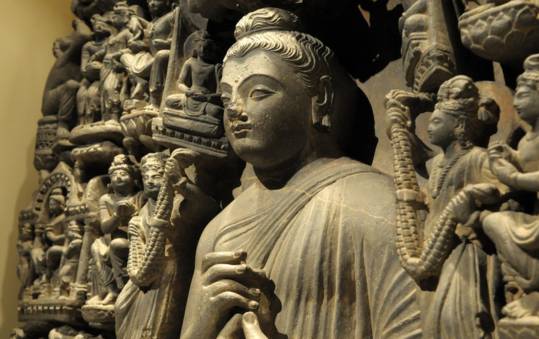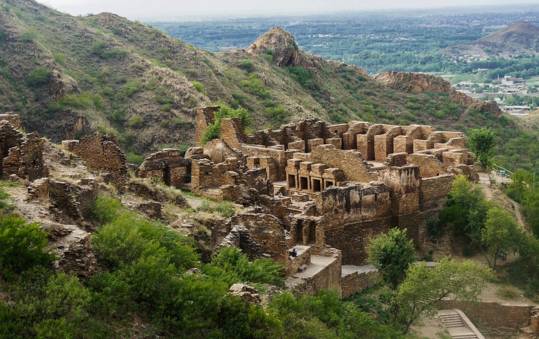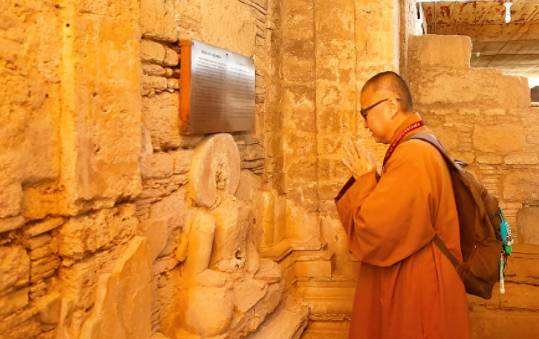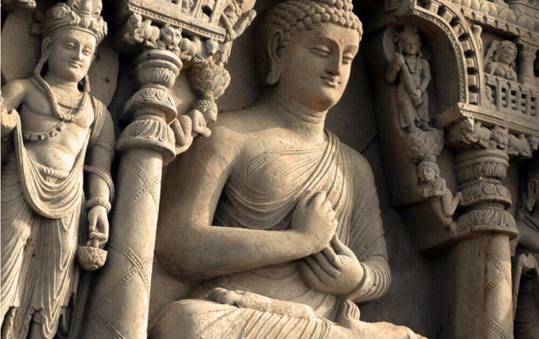Ancient Heritage of Pakistan
Home » Heritage of Pakistan » Exploring the Ancient Buddhist Heritage of Pakistan

Pakistan is a country rich in cultural and historical heritage that holds an extraordinary treasure of ancient Buddhist sites within its borders. These sites, spread across various areas, reflect the profound impact of Buddhism on the region’s history. As a traveler or culture enthusiast, understanding and exploring these Buddhist sites offers a unique glimpse into ancient times and spiritual evolution. This guide will take you through the fascinating world of Buddhist heritage in Pakistan, highlighting key sites, their historical significance, and practical tips for an enriching visit.
Historical Background of Buddhism in Pakistan
In the 3rd century BCE, Emperor Ashoka embraced Buddhism after the Kalinga War and sent missionaries to spread the teachings of Buddha beyond India. Pakistan, strategically located on ancient trade routes, became a famous spot for Buddhist thought and practice. The spread of Buddhism in Pakistan was further facilitated by the Gandhara civilization, renowned for its unique blend of Greco-Buddhist art and culture.
Cultural and Historical Significance of Ancient Buddhist Heritage in Pakistan

The ancient Buddhist heritage in Pakistan is a demonstration of our country’s diversity and inclusivity. The Buddhist sites offer valuable insights into the spread of Buddhism and its influence on local art, architecture, and societal values. The blend of Buddhist and local traditions has enriched the historical narrative of Pakistan.
Key Influence of Gandhara Civilization on Buddhist Heritage in Pakistan
The Gandhara civilization, flourishing between the 1st century BCE and the 5th century CE, played a crucial role in shaping Buddhist heritage in Pakistan. The fusion of Hellenistic and Indian artistic traditions led to the creation of distinctive Buddhist art and architecture. Buddhist monks and scholars have played an integral role in Buddhist philosophy and practice.
Major artifacts and sites from this period include exceptional sculptures, stupas, and monastic complexes that continue to draw attention of scholars and tourists. The Gandhara civilization left a lasting legacy on Buddhist art and architecture. Its influence is evident in the iconic Gandharan art style, characterized by its realistic depictions of Buddha and Bodhisattvas, and the architectural features of stupas and monasteries.
Key Buddhist Sites in Pakistan to Visit
Taxila
Taxila is a UNESCO World Heritage site that is one of the most significant Buddhist centers in Pakistan. This historic city, located near Islamabad, serves as a center for Buddhist learning and culture. Visitors to Taxila can explore several key sites:
- Sirkap: An ancient city founded by the Indo-Greek king Menander, known for its well-preserved ruins and historical significance.
- Sirsukh: A city that followed the architectural principles of Greek and Roman styles, offering insights into the urban planning of the Gandhara period.
- Dharmarajika Stupa: One of the oldest and largest stupas in Taxila, believed to house relics of Buddha.
Swat Valley
Swat Valley, recognized as the “Switzerland of the East,” is another prominent Buddhist center. The valley’s serene landscape is dotted with ancient Buddhist sites:
- Butkara Stupa: An important stupa built during the reign of the Kushan Empire, renowned for its architectural grandeur and historical significance.
- Udegram Monastic Complex: A cluster of monastic buildings that provides insights into the daily life of Buddhist monks and the architectural style of the period.
Takht-i-Bahi
Takht-i-Bahi, located in the Mardan District of Khyber Pakhtunkhwa, is a well-preserved Buddhist monastery complex. Takht-i-Bahi isa UNESCO World Heritage site, which provides an insight into the lives of ancient Buddhist life. The site features:
- Monastic Buildings: Remains of monastic cells, prayer halls, and stupas.
- Architectural Features: An impressive layout that includes a central courtyard surrounded by monastic buildings and stupas.
Peshawar
Peshawar is a city with a rich history that played a significant role in the spread of Buddhism. Key Buddhist sites in Peshawar include:
- Kanishka Stupa: A monumental stupa built during the reign of Emperor Kanishka, known for its massive size and historical importance.
- Peshawar Museum: Home to a vast collection of Gandharan artifacts, including sculptures, coins, and manuscripts that provide valuable insights into the Buddhist heritage of the region.
Lahore
Lahore is a city known for its vibrant culture and history that also has connections to Buddhist heritage:
- Lahore Museum: The museum houses an extensive collection of Buddhist artifacts, including sculptures, inscriptions, and ancient relics that highlight the region’s Buddhist past.
Planning Your Trip

Best Times to Visit
The best times to visit Buddhist sites in Pakistan are during the spring (March to May) and autumn (September to November) when the weather is pleasant and suitable for sightseeing. Summer can be extremely hot, and winter may bring harsh conditions to certain regions.
What to See and Do at Each Site
Taxila: Explore the ruins of Sirkap and Sirsukh, and visit the Dharmarajika Stupa. Take time to appreciate the intricate carvings and architectural features that reflect the Gandharan art style.
Swat Valley: Visit this destination to explore the Butkara Stupa and Udegram Monastic Complex. Enjoy the serene landscape and learn about the historical significance of these sites.
Takht-i-Bahi: Wander through the well-preserved monastery complex and explore the monastic buildings and stupas. Take in the architectural layout and imagine the daily life of ancient Buddhist monks.
Peshawar: Admire the magnificence of the Kanishka Stupa and explore the Peshawar Museum’s collection of Gandharan artifacts. Gain insights into the region’s Buddhist history and artistic achievements.
Lahore: Visit the Lahore Museum to view its extensive collection of Buddhist artifacts. Discover the exhibitions of the museum and understand the historical context of these relics.
Preparation Tips
Research and Plan Ahead: Learn about the key Buddhist sites you plan to visit and create an itinerary according to the locations you want to explore. You can also handle your travel plan with trusted tour operators like Rawaan Pak.
Visas and Permits: Carry valid visa for Pakistan. If any site requires special permits for visitors, check in advance and obtain any necessary permissions.
Stay Hydrated and Healthy: Carry bottled water and stay hydrated, especially if traveling in warmer regions. Be cautious about food and drink to avoid health issues.
Learn Basic Local Phrases: While English is widely spoken in tourist areas, learning a few basic phrases in Urdu can be helpful and appreciated by locals.
Cultural Etiquette: When visiting Buddhist sites, dress modestly and remove your shoes before entering religious areas. Check if photography is allowed at the sites and be mindful of any restrictions or guidelines. Interact with local communities with respect.
Responsible Tourism: Follow guidelines to minimize your impact on the sites. Avoid touching or leaning on ancient structures and contribute to local conservation efforts by respecting the heritage.
Engage a Local Guide: Consider hiring a local guide to enhance your experience. Guides can provide valuable insights into the history and significance of the sites and help navigate the area, this will make your trip more informative and engaging.
Preservation Efforts for Buddhist Heritage
Ongoing research and preservation projects aim to uncover new insights into the region’s Buddhist past and ensure the protection of its heritage. Measures include advanced restoration techniques, increased international collaboration, and enhanced public awareness about the significance of these ancient sites.
Impact of Ancient Buddhist Heritage on Contemporary Culture and Tourism
The ancient Buddhist heritage continues to influence modern Pakistani culture and tourism. The remains of Buddhist art and architecture in Pakistan represent contemporary freedom of expression in terms of acceptance of diverse religious beliefs. The preservation of these sites attract tourists from around the world. The promotion of Buddhist heritage helps foster cultural exchange and appreciation across the globe.

In Summary
Ancient Buddhist heritage in Pakistan offers a spiritually enlightening journey through time, showcasing the region’s enriching culture and history. From the majestic stupas of Taxila to the serene monasteries of Takht-i-Bahi, each site provides a unique glimpse into the Buddhist past. Exploring these sites not only enhances our understanding of history but also emphasizes the importance of preserving and celebrating our shared heritage.
Booking
Top Tours
FAQ'S
The most important Buddhist site in Pakistan is Taxila, known for its extensive ruins and significant historical value. Key attractions include the Dharmarajika Stupa and the ancient cities of Sirkap and Sirsukh.
Prepare for your tour by researching the best times to visit, obtaining necessary permits and visas, and familiarizing yourself with local customs. Consider hiring a local guide for an enriching experience.
Accommodations range from budget guesthouses and hotels to more upscale options near major sites. In tourist areas like Taxila and Swat Valley, you’ll find a variety of lodging options. Booking in advance is recommended, especially during peak travel seasons. With the guided tour services by Rawaan Pak, you can get the finest accommodation with zero hassle.
Yes, guided tours are available for exploring Buddhist sites in Pakistan. Local tour operators offer comprehensive packages that include visits to key sites, transportation, and knowledgeable guides. We at Rawaan Pak, provide professional tour guides who carefully plan your Buddhist pilgrimage tour considering your budget, time duration, and preference. From transportation and accommodation to amenities, we ensure your trip is convenient and pleasurable with us.


